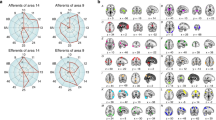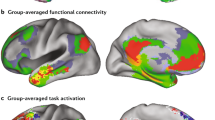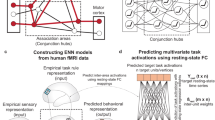Abstract
The human brain is a complex network that supports mental function. The nascent field of network neuroscience applies tools from mathematics to neuroimaging data in the hope of shedding light on cognitive function. A critical question arising from these empirical studies is how to modulate a human brain network to treat cognitive deficits or enhance mental abilities. While historically a number of tools have been employed to modulate mental states (such as cognitive behavioural therapy and brain stimulation), theoretical frameworks to guide these interventions—and to optimize them for clinical use—are fundamentally lacking. One promising and as yet under-explored approach lies in a subdiscipline of engineering known as network control theory. Here, we posit that network control fundamentally relates to mind control, and that this relationship highlights important areas for future empirical research and opportunities to translate knowledge into practical domains. We clarify the conceptual intersection between neuroanatomy, cognition, and control engineering in the context of network neuroscience. Finally, we discuss the challenges, ethics, and promises of mind control.
This is a preview of subscription content, access via your institution
Access options
Access Nature and 54 other Nature Portfolio journals
Get Nature+, our best-value online-access subscription
$29.99 / 30 days
cancel any time
Subscribe to this journal
Receive 12 digital issues and online access to articles
$119.00 per year
only $9.92 per issue
Buy this article
- Purchase on Springer Link
- Instant access to full article PDF
Prices may be subject to local taxes which are calculated during checkout




Similar content being viewed by others
References
Thaler, R. H., Sunstein, C. R. & Balz, J. P. in The Behavioral Foundations of Public Policy (ed. Shafir, E. ) Ch. 25 (Princeton Univ. Press, 2013).
Kailath, T. Linear Systems (Prentice-Hall, 1980).
Liu, Y.-Y., Slotine, J.-J. & Barabási, A.-L. Controllability of complex networks. Nature 473, 167–173 (2011).
Gu, S. et al. Controllability of structural brain networks. Nat. Commun. 6, 8414 (2015).
Muldoon, S. F. et al. Stimulation-based control of dynamic brain networks. PLoS Comput. Biol. 12, e1005076 (2016).
Humayun, M. et al. Recent results from second sight's Argus® II retinal prosthesis study. Invest. Ophthalmol. Vis. Sci. 54, 349–349 (2013).
Arts, R. A., George, E. L., Stokroos, R. J. & Vermeire, K. Review: cochlear implants as a treatment of tinnitus in single-sided deafness. Curr. Opin. Otolaryngol. Head Neck Surg. 20, 398–403 (2012).
Schiff, S. J. Neural Control Engineering (MIT Press, 2012).
Figee, M. et al. Deep brain stimulation restores frontostriatal network activity in obsessive-compulsive disorder. Nat. Neurosci. 16, 386–387 (2013).
Mayberg, H. S. et al. Deep brain stimulation for treatment-resistant depression. Neuron 45, 651–660 (2005).
Hallett, M. Transcranial magnetic stimulation and the human brain. Nature 406, 147–150 (2000).
Bassett, D. S. & Bullmore, E. Small-world brain networks. Neuroscientist 12, 512–523 (2006).
Bullmore, E. & Sporns, O. Complex brain networks: graph theoretical analysis of structural and functional systems. Nat. Rev. Neurosci. 10, 186–198 (2009).
Bullmore, E. T. & Bassett, D. S. Brain graphs: graphical models of the human brain connectome. Annu. Rev. Clin. Psychol. 7, 113–140 (2011).
Betzel, R. F., Gu, S., Medaglia, J. D., Pasqualetti, F. & Bassett, D. S. Optimally controlling the human connectome: the role of network topology. Sci. Rep. 6, 30770 (2016).
Pasqualetti, F., Zampieri, S. & Bullo, F. Controllability metrics, limitations and algorithms for complex networks. IEEE Trans. Control Network Syst. 1, 40–52 (2014).
Lee, E. B. & Markus, L. Foundations of Optimal Control Theory (Krieger Publishing Company, 1967).
Stigen, T., Danzl, P., Moehlis, J. & Netoff, T. Controlling spike timing and synchrony in oscillatory neurons. BMC Neurosci. 12, P223 (2011).
Nabi, A. & Moehlis, J. Single input optimal control for globally coupled neuron networks. J. Neural Eng. 8, 065008 (2011).
Sarma, S. V. et al. Using point process models to compare neural spiking activity in the subthalamic nucleus of Parkinson's patients and a healthy primate. IEEE Trans. Biomed. Eng. 57, 1297–1305 (2010).
Greenberg, B. D. et al. Three-year outcomes in deep brain stimulation for highly resistant obsessive–compulsive disorder. Neuropsychopharmacology 31, 2384–2393 (2006).
Gu, S. et al. Optimal trajectories of brain state transitions. NeuroImage 148, 305–317 (2017).
Sporns, O., Tononi, G. & Kötter, R. The human connectome: a structural description of the human brain. PLoS Comput. Biol. 1, e42 (2005).
Miniussi, C., Harris, J. A. & Ruzzoli, M. Modelling non-invasive brain stimulation in cognitive neuroscience. Neurosci. Biobehav. Rev. 37, 1702–1712 (2013).
Brunoni, A. R. et al. Clinical research with transcranial direct current stimulation (tDCS): challenges and future directions. Brain Stimul. 5, 175–195 (2012).
Teneback, C. C. et al. Changes in prefrontal cortex and paralimbic activity in depression following two weeks of daily left prefrontal TMS. J. Neuropsychiatry Clin. Neurosci. 11, 426–435 (2015).
Nitsche, M. tDCS/tACS and plasticity. Clin. Neurophysiol. 127, e32 (2016).
Ruths, J. & Ruths, D. Control profiles of complex networks. Science 343, 1373–1376 (2014).
Medaglia, J. D., Lynall, M.-E. & Bassett, D. S. Cognitive network neuroscience. J. Cogn. Neurosci. 27, 1471–1491 (2015).
Miller, E. K. & Cohen, J. D. An integrative theory of prefrontal cortex function. Annu. Rev. Neurosci. 24, 167–202 (2001).
Dosenbach, N. U. et al. Distinct brain networks for adaptive and stable task control in humans. Proc. Natl Acad. Sci. USA 104, 11073–11078 (2007).
Watanabe, T., Masuda, N., Megumi, F., Kanai, R. & Rees, G. Energy landscape and dynamics of brain activity during human bistable perception. Nat. Commun. 5, 4765 (2014).
Corbetta, M. & Shulman, G. L. Control of goal-directed and stimulus-driven attention in the brain. Nat. Rev. Neurosci. 3, 201–215 (2002).
Sestieri, C., Corbetta, M., Spadone, S., Romani, G. L. & Shulman, G. L. Domain-general signals in the cingulo-opercular network for visuospatial attention and episodic memory. J. Cogn. Neurosci. 26, 551–568 (2014).
Raichle, M. E. et al. A default mode of brain function. Proc. Natl Acad. Sci. USA 98, 676–682 (2001).
Fox, M. D., Corbetta, M., Snyder, A. Z., Vincent, J. L. & Raichle, M. E. Spontaneous neuronal activity distinguishes human dorsal and ventral attention systems. Proc. Natl Acad. Sci. USA 103, 10046–10051 (2006).
Fox, M. D. & Raichle, M. E. Spontaneous fluctuations in brain activity observed with functional magnetic resonance imaging. Nat. Rev. Neurosci. 8, 700–711 (2007).
Bassett, D. S. & Gazzaniga, M. S. Understanding complexity in the human brain. Trends Cogn. Sci. 15, 200–209 (2011).
Panzeri, S., Brunel, N., Logothetis, N. K. & Kayser, C. Sensory neural codes using multiplexed temporal scales. Trends Neurosci. 33, 111–120 (2010).
Sutskever, I., Vinyals, O. & Le, Q. V. Sequence to sequence learning with neural networks. In Advances in Neural Information Processing Systems (eds Ghahramani, Z., Welling, M. et al.) 3104–3112 (MIT Press, 2014).
Merchant, H., Harrington, D. L. & Meck, W. H. Neural basis of the perception and estimation of time. Annu. Rev. Neurosci. 36, 313–336 (2013).
Stolier, R. M. & Freeman, J. B. Neural pattern similarity reveals the inherent intersection of social categories. Nat. Neurosci. 19, 795–797 (2016).
Bassett, D. S., Yang, M., Wymbs, N. F. & Grafton, S. T. Learning-induced autonomy of sensorimotor systems. Nat. Neurosci. 18, 744–751 (2015).
Calhoun, V. D., Miller, R., Pearlson, G. & Adalı, T. The chronnectome: time-varying connectivity networks as the next frontier in fMRI data discovery. Neuron 84, 262–274 (2014).
Shamir, M. Emerging principles of population coding: in search for the neural code. Curr. Opin. Neurobiol. 25, 140–148 (2014).
Zaslaver, A. et al. Hierarchical sparse coding in the sensory system of Caenorhabditis elegans. Proc. Natl Acad. Sci. USA 112, 1185–1189 (2015).
Lisman, J. E. & Jensen, O. The theta-gamma neural code. Neuron 77, 1002–1016 (2013).
Miura, K., Mainen, Z. F. & Uchida, N. Odor representations in olfactory cortex: distributed rate coding and decorrelated population activity. Neuron 74, 1087–1098 (2012).
Ainsworth, M. et al. Rates and rhythms: a synergistic view of frequency and temporal coding in neuronal networks. Neuron 75, 572–583 (2012).
Csiszar, I. & Körner, J. Information Theory: Coding Theorems for Discrete Memoryless Systems (Cambridge Univ. Press, 2011).
Pressley, M. & Hilden, K. in Handbook of Child Psychology Vol. 2 (eds Damon, W. & Lerner, R. M. ) Ch. 12 (Wiley, 2006).
Van Gelder, T. What might cognition be, if not computation? J. Philos. 92, 345–381 (1995).
Sowell, E. R. et al. Mapping cortical change across the human life span. Nat. Neurosci. 6, 309–315 (2003).
Draganski, B. et al. Temporal and spatial dynamics of brain structure changes during extensive learning. J. Neurosci. 26, 6314–6317 (2006).
Lan, M. J., Chhetry, B. T., Liston, C., Mann, J. J. & Dubin, M. Transcranial magnetic stimulation of left dorsolateral prefrontal cortex induces brain morphological changes in regions associated with a treatment resistant major depressive episode: an exploratory analysis. Brain Stimul. 9, 577–583 (2016).
Betzel, R. F. & Bassett, D. S. Multi-scale brain networks. NeuroImage (in the press).
Karamintziou, S. et al. Design of a novel closed-loop deep brain stimulation system for Parkinson's disease and obsessive-compulsive disorder. In Proc. 7th International IEEE/EMBS Conference on Neural Engineering 860–863 (IEEE, 2015).
Reis, J. et al. Noninvasive cortical stimulation enhances motor skill acquisition over multiple days through an effect on consolidation. Proc. Natl Acad. Sci. USA 106, 1590–1595 (2009).
Snowball, A. et al. Long-term enhancement of brain function and cognition using cognitive training and brain stimulation. Curr. Biol. 23, 987–992 (2013).
Deisseroth, K. Optogenetics. Nat. Methods 8, 26–29 (2011).
Barker, A. T., Jalinous, R. & Freeston, I. L. Non-invasive magnetic stimulation of human motor cortex. Lancet 325, 1106–1107 (1985).
Silvanto, J., Muggleton, N. & Walsh, V. State-dependency in brain stimulation studies of perception and cognition. Trends Cogn. Sci. 12, 447–454 (2008).
Fox, M. D. et al. Resting-state networks link invasive and noninvasive brain stimulation across diverse psychiatric and neurological diseases. Proc. Natl Acad. Sci. USA 111, E4367–E4375 (2014).
George, M. S. & Aston-Jones, G. Noninvasive techniques for probing neurocircuitry and treating illness: vagus nerve stimulation (VNS), transcranial magnetic stimulation (TMS) and transcranial direct current stimulation (tDCS). Neuropsychopharmacology 35, 301–316 (2010).
Finn, E. S. et al. Functional connectome fingerprinting: identifying individuals using patterns of brain connectivity. Nat. Neurosci. 11, 1664 (2015).
Kozai, T. D. Y. et al. Ultrasmall implantable composite microelectrodes with bioactive surfaces for chronic neural interfaces. Nat. Mater. 11, 1065–1073 (2012).
Grosenick, L., Marshel, J. H. & Deisseroth, K. Closed-loop and activity-guided optogenetic control. Neuron 86, 106–139 (2015).
Mullen, T. R. et al. Real-time neuroimaging and cognitive monitoring using wearable dry EEG. IEEE Trans. Biomed. Eng. 62, 2553–2567 (2015).
Zotev, V., Phillips, R., Yuan, H., Misaki, M. & Bodurka, J. Self-regulation of human brain activity using simultaneous real-time fMRI and EEG neurofeedback. NeuroImage 85, 985–995 (2014).
Sitaram, R. et al. Closed-loop brain training: the science of neurofeedback. Nat. Rev. Neurosci. 18, 86–100 (2016).
Florin, E., Bock, E. & Baillet, S. Targeted reinforcement of neural oscillatory activity with real-time neuroimaging feedback. Neuroimage 88, 54–60 (2014).
Kalman, R. E. A new approach to linear filtering and prediction problems. J. Basic Eng. 82, 35–45 (1960).
Tarokh, M. Measures for controllability, observability and fixed modes. IEEE Trans. Automat. Contr. 37, 1268–1273 (1992).
Norman, K. A., Polyn, S. M., Detre, G. J. & Haxby, J. V. Beyond mind-reading: multi-voxel pattern analysis of fMRI data. Trends Cogn. Sci. 10, 424–430 (2006).
Kopell, N. J., Gritton, H. J., Whittington, M. A. & Kramer, M. A. Beyond the connectome: the dynome. Neuron 83, 1319–1320 (2014).
Motter, A. E. Networkcontrology. Chaos 25, 097621 (2015).
Tang, E. & Bassett, D. S. Control of dynamics in brain networks. Preprint at https://arxiv.org/abs/1701.01531 (2017).
Sotero, R. C., Trujillo-Barreto, N. J., Iturria-Medina, Y., Carbonell, F. & Jimenez, J. C. Realistically coupled neural mass models can generate EEG rhythms. Neural Comput. 19, 478–512 (2007).
Brown, E., Moehlis, J. & Holmes, P. On the phase reduction and response dynamics of neural oscillator populations. Neural Comput. 16, 673–715 (2004).
Kilpatrick, Z. P. in Encyclopedia of Computational Neuroscience (eds Jaeger, D. & Jung, R. ) 3159–3163 (Springer, 2015).
Denslow, S., Lomarev, M., George, M. S. & Bohning, D. E. Cortical and subcortical brain effects of transcranial magnetic stimulation (TMS)-induced movement: an interleaved TMS/functional magnetic resonance imaging study. Biol. Psychiatry 57, 752–760 (2005).
Groppa, S. et al. Subcortical substrates of TMS induced modulation of the cortico-cortical connectivity. Brain Stimul. 6, 138–146 (2013).
Nowzari, C., Preciado, V. M. & Pappas, G. J. Analysis and control of epidemics: a survey of spreading processes on complex networks. IEEE Control Syst. 36, 26–46 (2016).
Bouton, C. E. et al. Restoring cortical control of functional movement in a human with quadriplegia. Nature 533, 247–250 (2016).
Zhao, S. & Iyengar, R. Systems pharmacology: network analysis to identify multiscale mechanisms of drug action. Annu. Rev. Pharmacol. Toxicol. 52, 505 (2012).
Rosenbaum, D. A. The Cinderella of psychology: the neglect of motor control in the science of mental life and behavior. Am. Psychol. 60, 308 (2005).
Frank, M. J., Samanta, J., Moustafa, A. A. & Sherman, S. J. Hold your horses: impulsivity, deep brain stimulation, and medication in parkinsonism. Science 318, 1309–1312 (2007).
Churchland, P. S. & Sejnowski, T. J. Neural Representation and Neural Computation (MIT Press, 1989).
Hamilton, R., Messing, S. & Chatterjee, A. Rethinking the thinking cap ethics of neural enhancement using noninvasive brain stimulation. Neurology 76, 187–193 (2011).
Shamoo, A. E. & Resnik, D. B. Responsible Conduct of Research (Oxford Univ. Press, 2009).
Bronstein, J. M. et al. Deep brain stimulation for Parkinson disease: an expert consensus and review of key issues. Arch. Neurol. 68, 165–165 (2011).
Pinsker, M., Amtage, F., Berger, M., Nikkhah, G. & van Elst, L. T. in Stereotactic and Functional Neurosurgery 47–51 (Springer, 2013).
Been, G., Ngo, T. T., Miller, S. M. & Fitzgerald, P. B. The use of tDCS and CVS as methods of non-invasive brain stimulation. Brain Res. Rev. 56, 346–361 (2007).
Krause, B., Márquez-Ruiz, J. & Kadosh, R. C. The effect of transcranial direct current stimulation: a role for cortical excitation/inhibition balance? Front. Hum. Neurosci. 7, 602 (2013).
Sarkar, A., Dowker, A. & Kadosh, R. C. Cognitive enhancement or cognitive cost: trait-specific outcomes of brain stimulation in the case of mathematics anxiety. J. Neurosci. 34, 16605–16610 (2014).
Iuculano, T. & Kadosh, R. C. The mental cost of cognitive enhancement. J. Neurosci. 33, 4482–4486 (2013).
Bertsekas, D. P. Dynamic Programming and Optimal Control Vol. 1 (Athena Scientific, 1995).
Wear, S. & Moreno, J. D. Informed consent: patient autonomy and physician beneficence within clinical medicine. HEC Forum 6, 323–325 (Springer, 1994).
Lentz, J., Kennett, M., Perlmutter, J. & Forrest, A. Paving the way to a more effective informed consent process: recommendations from the clinical trials transformation initiative. Contemp. Clin. Trials 49, 65–69 (2016).
McCabe, S. E., Knight, J. R., Teter, C. J. & Wechsler, H. Non-medical use of prescription stimulants among US college students: prevalence and correlates from a national survey. Addiction 100, 96–106 (2005).
Sahakian, B. & Morein-Zamir, S. Professor's little helper. Nature 450, 1157–1159 (2007).
Fox, D. Brain buzz. Nature 472, 156–159 (2011).
Wilson, R. A. & Lenart, B. A. in Handbook of Neuroethics 423–439 (Springer, 2015).
Riis, J., Simmons, J. P. & Goodwin, G. P. Preferences for enhancement pharmaceuticals: the reluctance to enhance fundamental traits. J. Consum. Res. 35, 495–508 (2008).
Olson, E. T. The Human Animal: Personal Identity Without Psychology (Oxford Univ. Press, 1999).
Singer, P. Practical Ethics (Cambridge Univ. Press, 2011).
Dennett, D. C. Elbow Room: The Varieties of Free Will Worth Wanting (MIT Press, 2015).
Brodmann, K. Vegleichende Lokalisationslehre der Grosshirnde (Barth, 1909).
Acknowledgements
The authors thank J. Gold, E. Karuza and R. Betzel for helpful comments and discussion regarding this work. J.D.M. acknowledges support from the Office of the Director at the National Institutes of Health through grant number 1-DP5-OD-021352-01. D.S.B. acknowledges support from the John D. and Catherine T. MacArthur Foundation, the Alfred P. Sloan Foundation, the Army Research Laboratory and the Army Research Office through contract numbers W911NF-10-2-0022 and W911NF-14-1-0679, the National Institute of Health (2-R01-DC-009209-11, 1R01HD086888-01, R01-MH107235, R01-MH107703, R01MH109520, 1R01NS099348 and R21-M MH-106799), the Office of Naval Research, and the National Science Foundation (BCS-1441502, CAREER PHY-1554488, BCS-1631550, and CNS-1626008). W.S.-A. acknowledges support from the John Templeton Foundation. The content is solely the responsibility of the authors and does not necessarily represent the official views of any of the funding agencies.
Author information
Authors and Affiliations
Contributions
J.D.M. wrote the manuscript. P.Z. and W.S.-A. provided feedback and contributed substantially to the conceptualization and editing of ‘The ethics of brain control’. D.S.B. contributed organizational and conceptual input and editing throughout the manuscript.
Corresponding author
Ethics declarations
Competing interests
The authors declare no competing interests.
Rights and permissions
About this article
Cite this article
Medaglia, J., Zurn, P., Sinnott-Armstrong, W. et al. Mind control as a guide for the mind. Nat Hum Behav 1, 0119 (2017). https://doi.org/10.1038/s41562-017-0119
Received:
Accepted:
Published:
DOI: https://doi.org/10.1038/s41562-017-0119
This article is cited by
-
Statistical inference links data and theory in network science
Nature Communications (2022)
-
Moral Framing and Mechanisms Influence Public Willingness to Optimize Cognition
Journal of Cognitive Enhancement (2021)
-
Resting fMRI-guided TMS results in subcortical and brain network modulation indexed by interleaved TMS/fMRI
Experimental Brain Research (2021)
-
Protecting Decision-Making in the Era of Neuromodulation
Journal of Cognitive Enhancement (2020)
-
Haptics-mediated approaches for enhancing sustained attention: framework and challenges
Science China Information Sciences (2019)



